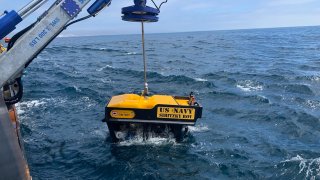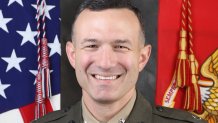
Marine officials said on Tuesday that the commander of the landing team whose amphibious vehicle sank during a training operation off the shore of San Clemente Island in July had been relieved "due to a loss in trust and confidence in his ability to command as a result of the assault amphibious vehicle mishap that took place off the coast of Southern California July 30, 2020."
Lt. Col. Michael J. Regner was relieved of command on Tuesday by Lt. Gen. Karsten S. Heckl, the commanding general of the I Marine Expeditionary Force, according to a news release issued by the Marines.
Sixteen crew members were on board the AAV when it sank. One Marine was pronounced dead at the scene of the incident. Seven others were rescued, with two transported to the hospital with critical injuries. Another eight service members were missing and later presumed dead.

Marine officials said the investigation into the incident is not yet complete.
"Although the Command Investigation has compiled a substantial amount of information and data which formed the basis for Heckl’s decision, it is still ongoing as the Marine Corps continues to investigate, assess all relevant information and take appropriate actions," the new release also said.
The sunken amphibious assault vehicle was found in August, U.S. Marine Corps officials announced Tuesday.
U.S. & World
Crews with the 15th Marine Expeditionary Unit (MEU), I Marine Expeditionary Force (MEF), and the Makin Island Amphibious Ready Group (ARG) located the amphibious assault vehicle (AAV), USMC officials at Camp Pendleton said in August.
The 15th MEU confirmed the U.S. Navy’s Undersea Rescue Command had detected human remains, believed to be the eight crewmembers, near the sunken AAV.
The AAV sank to a depth of about 385 feet during an evening "shore-to-ship" training maneuver off the coast of San Clemente Island – about 78 miles away from San Diego – on July 30.
The identities of the service members presumed dead were:
- Pfc. Bryan J. Baltierra, 18, of Corona, California, a rifleman with Bravo Company, BLT 1/4, 15th MEU.
- Lance Cpl. Marco A. Barranco, 21, of Montebello, California, a rifleman with Bravo Company, BLT 1/4, 15th MEU.
- Pfc. Evan A. Bath, 19, of Oak Creek, Wisconsin, a rifleman with Bravo Company, BLT 1/4, 15th MEU.
- U.S. Navy Hospitalman Christopher Gnem, 22, of Stockton, California, a hospital corpsman with Bravo Company, BLT 1/4, 15th MEU.
- Pfc. Jack Ryan Ostrovsky, 20, of Bend, Oregon, a rifleman with Bravo Company, BLT 1/4, 15th MEU.
- Cpl. Wesley A. Rodd, 22, of Harris, Texas, a rifleman with Bravo Company, BLT 1/4, 15th MEU.
- Lance Cpl. Chase D. Sweetwood, 18, of Portland, Oregon, a rifleman with Bravo Company, BLT 1/4, 15th MEU.
- Cpl. Cesar A. Villanueva, 21, of Riverside, California, a rifleman with Bravo Company, BLT 1/4, 15th MEU.
Lance Cpl. Guillermo S. Perez, 19, of New Braunfels, Texas, was identified as the crewmember who was recovered and pronounced died at the scene. He was a rifleman with Bravo Company, Battalion Landing Team (BLT) 1/4, 15th MEU.
NBC San Diego spoke with the family of Cesar Villanueva. His mother remembered him as a kind, respectable, and outgoing young man.
"He was calm and outgoing. He wanted to enter the Marines because he wanted to serve his country," Maria Villanueva said.
The AAV 'Training Mishap': What Happened?
A total of 15 Marines and one Navy sailor were inside the AAV when the group reported taking on water around 5:45 p.m. on July 30, the USMC said.
The group was traveling from the shores of San Clemente Island to a Navy ship when the AVV started sinking about halfway through their training routine, according to Lt. Cameron H. Edinburgh, a Marine Corps spokesman for Camp Pendleton.
The 26-ton, tank-like craft sank in hundreds of feet of water — too deep for divers — making it difficult to reach.
Eight Marines – or half of the service members involved in the incident – were rescued from the sunken AVV that day. Two of them, in critical condition, were taken to Scripps Memorial Hospital in San Diego.
The injured were later identified as a Marine rifleman with Bravo Company, BLT 1/4, 15th MEU, and a Marine assault amphibious vehicle crewmember with Mechanized Company, BLT 1/4, 15th MEU. The Marine crewmember had been upgraded to stable condition over the weekend, per officials.
The investigation into the deadly incident is ongoing.
What Is an AAV and What About Prior Mishaps?
The Marines use the amphibious assault vehicles to transport troops and their equipment from Navy ships to land. They are nicknamed "amtracs" because the original name for the vehicle was “amphibious tractor.”
The armored vehicles, designed to be buoyant, can hold more than 20 passengers and up to 250 pounds of equipment and can weigh as much as 30 tons. They are outfitted with machine guns and grenade launchers. They look like tanks as they roll ashore for beach attacks, with Marines pouring out of them to take up positions.
The AAV involved in this incident had three water-tight hatches and two large troop hatches.
The vehicles have been used since 1972 and are continually refurbished.
The Marine Corps commandant, Gen. David Berger, suspended waterborne operations of all of its more than 800 amphibious assault vehicles across the branch until the cause of the accident is determined.
He said the move was out of “an abundance of caution.”
The July 30 mishap was the deadliest of several similar incidents involving amtracs that have occurred during Camp Pendleton exercises in less than a decade.
In 2011, a Marine was killed when an AAV sank during a training exercise in Oceanside Harbor. Six Marines were inside that AAV.
And in 2017, 14 Marines and one sailor were hospitalized after their AVV hit a natural gas line, igniting a fire that engulfed the landing craft during a training exercise at Camp Pendleton, the sprawling coastal Marine Corps base north of San Diego. One of the Marines was critically injured.
The Marine Expeditionary Force is the Marine Corps’ main warfighting organization. There are three such groups, each of which are made up of ground, air and logistics forces.



